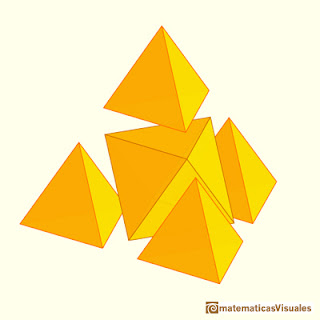While I was trying to come up with some maker-style projects that we could work on this summer, I found this idea for a Sierpinski Tetrahedron on Pinterest. (It is a pyramid too, but a special type of pyramid where all four sides are triangles, even equilateral triangles!)
I wish I had a classroom full of kids to help me build this, but, alas, I have only 2 students! And since I knew they were not going to be interested in folding a bunch of paper pyramids, I decided to make one myself.
And here is my tetrahedron! Not nearly as impressive as the one above, but still pretty cool.
The tetrahedrons don't like to stay stacked, so I used bits of wire (snipped and flattened paper clips!) that I threaded inside and then glued them all together. There's a nice set of instructions at yale.edu for folding tetrahedrons out of envelopes. This looks like a much easier method, but the origami paper is way prettier!
You could also try a paper coloring version of a Sierpinski Triangle (now we're talking 2 dimensions). I really love this idea, but again, you do need a bunch of students to really make this work. Nobody wants to color that many triangles on their own! This activity is from the Fractal Foundation, and they have a printable that you can download for your kids to color.
Which leads me to why Sierpinski triangles (and tetrahedrons) are so fascinating. They are fractals! Which basically means that they exhibit a repeating pattern at any scale. So you could zoom in and zoom in and still see the same triangle structure. Conversely, you could keep zooming out, and it would still look the same! So I'm not an expert on fractals, but you could have your students read up on them here. That's the Fractal Foundation again and they even have a neat animation showing how you can keep zooming into a Sierpinski Triangle.
As I was creating my Sierpinski Pyramid, I began to wonder about the empty space in the center. What shape was being removed from the pyramid? In the triangle (2D version), you keep removing triangles, but in the tetrahedron, the removed space is not a tetrahedron. Turns out it is an octahedron!
Then I got to wondering about volumes. How does the volume of the octahedron compare to the volumes of the four tetrahedrons? I did some calculations and found that they are the same. So basically, you are removing half the volume of the pyramid each time you dig down into it. That seemed weird.
So I did some more investigation and found another website that confirmed this idea. At Matematicas Visuales, they have some fantastic graphics to help you visualize what is going on. And they show mathematically that the volume of the octahedron is equal to four times the volume of one tetrahedron (with same side lengths of course!) Have I bored you yet?
Bear with me for another minute. I also got to wondering what a reverse Sierpinski Tetrahedron might look like and found some wonderful examples at FractalNature.com. These are amazing!
Anyhow, perhaps your kids would like to tackle a project like this over the summer. I worked with the triangle based pyramid. But I wonder if you can create a Sierpinski pyramid using a square based pyramid? What would the shape of the missing space be? I'm not sure this would really be a fractal shape since the five sides of the pyramid would not be the same size/shape, but it's an interesting line of inquiry.
If you are more interested in the 2D versions, there are many different ways to construct a Sierpinski Triangle. Check out the Wikipedia article about Sierpinski Triangles for more info about that.
Here's an example of a Sierpinski Carpet that I whipped up in Photoshop. You can also try to build a 3D version of this fractal. It's called a Menger Sponge!
I hope you and your students/children are inspired to create some mathy art this summer!
Happy Making!










4 comments:
hi, and thank you for this wanderful post!
can you pleas tell me how you linked the paper pyramidas to create the full sierpunsky pyramid? how did you make it satble? thankyou!
Hi Gilad,
I used clipped bits of paper clips that I had straightened out. I shoved them into the corner bits of the pyramids and glued them into place. Good luck creating one of your own!
Les
Hi! The original video of how you folded the tetrahedron is not available. Could you update the link? Thanks!
Sorry that the video is no longer available. Here is another that you can try!
https://www.youtube.com/watch?v=r4kmo3dsNIY
Post a Comment